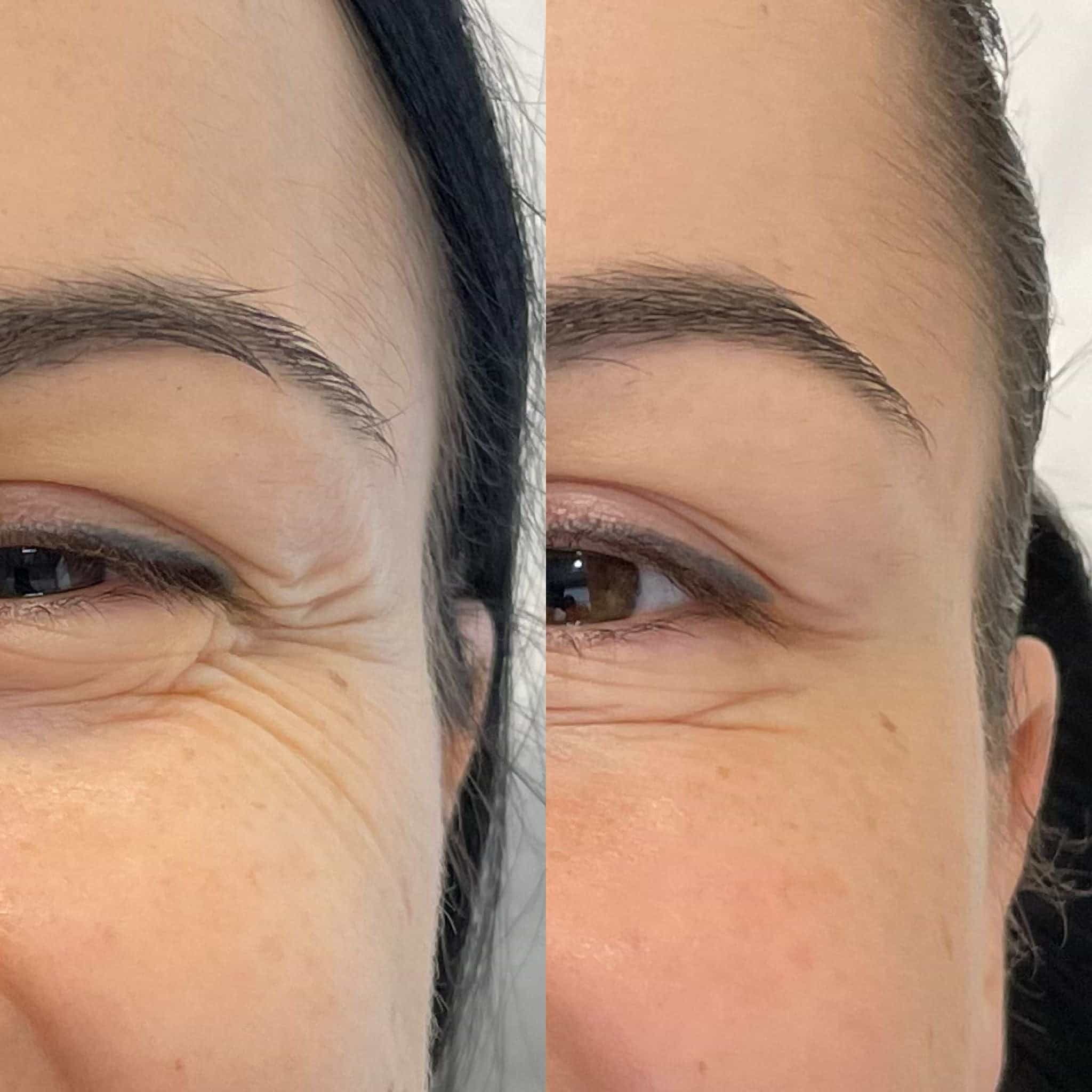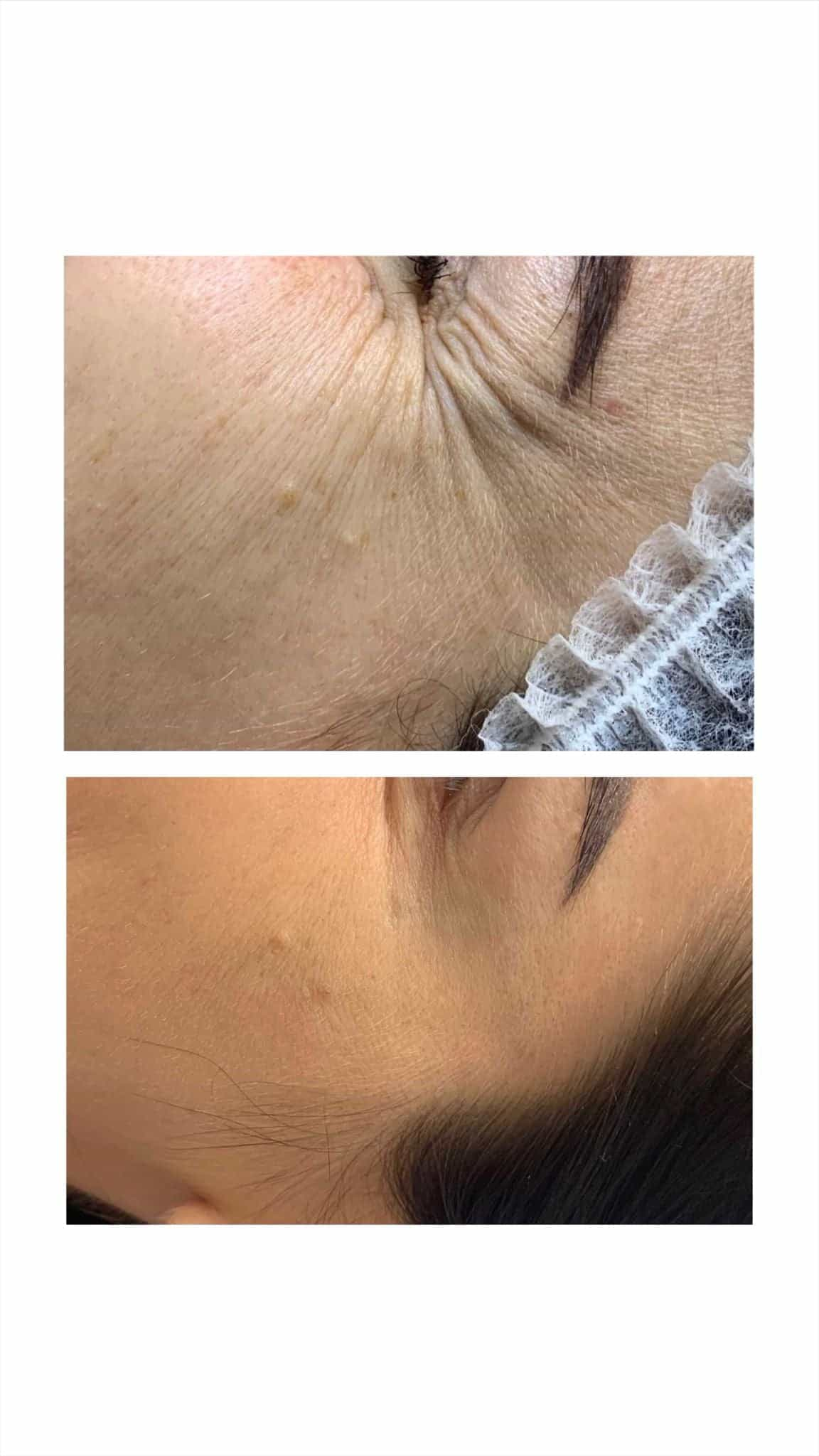How Botox Works
Botox has become increasingly popular for its ability to temporarily smooth out wrinkles, particularly those pesky crow’s feet that form around the eyes. This treatment works by targeting specific muscles responsible for facial expressions. When injected, Botox blocks the nerve signals that tell these muscles to contract, effectively paralyzing them. As a result, the targeted muscles relax, reducing the appearance of wrinkles and creating a smoother complexion.
The Mechanism of Action
Botox is derived from botulinum toxin, a neurotoxin produced by the bacterium Clostridium botulinum. While it’s known for its potentially harmful effects in large doses, Botox injections are carefully formulated in extremely small amounts to be safe and effective when administered correctly.
The mechanism of action involves blocking acetylcholine release at the neuromuscular junction. Acetylcholine is a neurotransmitter that transmits signals from nerves to muscles, causing them to contract. Botox binds to nerve endings, preventing the release of acetylcholine. This effectively disrupts the communication between nerves and muscles, leading to muscle paralysis.
When injected into specific facial muscles responsible for wrinkles, such as those around the eyes (crow’s feet), Botox prevents these muscles from contracting. Over time, as the muscle relaxes, the associated wrinkle softens and becomes less prominent.
Targeting Crow’s Feet Muscles
Botox has become increasingly popular in the UK for its ability to temporarily smooth out wrinkles, particularly those pesky crow’s feet that form around the eyes. This treatment works by targeting specific muscles responsible for facial expressions. When injected, Botox blocks the nerve signals that tell these muscles to contract, effectively paralyzing them. As a result, the targeted muscles relax, reducing the appearance of wrinkles and creating a smoother complexion.
Botox is derived from botulinum toxin, a neurotoxin produced by the bacterium Clostridium botulinum. While it’s known for its potentially harmful effects in large doses, Botox injections are carefully formulated in extremely small amounts to be safe and effective when administered correctly.
- The mechanism of action involves blocking acetylcholine release at the neuromuscular junction.
- Acetylcholine is a neurotransmitter that transmits signals from nerves to muscles, causing them to contract.
- Botox binds to nerve endings, preventing the release of acetylcholine.
- This effectively disrupts the communication between nerves and muscles, leading to muscle paralysis.
When injected into specific facial muscles responsible for wrinkles, such as those around the eyes (crow’s feet), Botox prevents these muscles from contracting. Over time, as the muscle relaxes, the associated wrinkle softens and becomes less prominent.
Benefits of Botox for Crow’s Feet
Botox has become a popular choice for reducing the appearance of crow’s feet, the fine lines that often appear at the corners of the eyes. This treatment involves injecting small amounts of botulinum toxin type A into specific muscles around the eyes. This temporarily paralyzes these muscles, preventing them from contracting and causing wrinkles.
Reduced Appearance of Wrinkles
Botox is a popular choice for reducing the appearance of crow’s feet, those fine lines that often appear at the corners of the eyes. This treatment involves injecting small amounts of botulinum toxin type A into specific muscles around the eyes. This temporarily paralyzes these muscles, preventing them from contracting and causing wrinkles.
The results of Botox injections for crow’s feet are typically noticeable within a few days to a week, with full effects seen after about two weeks. The wrinkle smoothing effect generally lasts for three to six months, at which point repeat treatments may be necessary to maintain the desired appearance.
Long-Lasting Results
Botox is a popular choice for reducing the appearance of crow’s feet, those fine lines that often appear at the corners of the eyes. This treatment involves injecting small amounts of botulinum toxin type A into specific muscles around the eyes. This temporarily paralyzes these muscles, preventing them from contracting and causing wrinkles.
The results of Botox injections for crow’s feet are typically noticeable within a few days to a week, with full effects seen after about two weeks. The wrinkle smoothing effect generally lasts for three to six months, at which point repeat treatments may be necessary to maintain the desired appearance.
Minimal Downtime
One of the biggest benefits of Botox for crow’s feet is its minimal downtime. Unlike some other cosmetic procedures, Botox injections are quick and relatively painless. You can typically resume your normal activities immediately after treatment.
The recovery time from a Botox injection is very short. Most people experience only mild temporary side effects such as redness or swelling at the injection site. These typically subside within a few days.
Procedure and Preparation

Before undergoing any cosmetic procedure, it’s essential to understand the process involved. When it comes to Botox for crow’s feet, preparation involves consulting with a qualified medical professional to determine if you are a suitable candidate and to discuss your desired outcomes.
Consultation with a Specialist
Before undergoing any cosmetic procedure, it’s essential to understand the process involved. When it comes to Botox for crow’s feet, preparation involves consulting with a qualified medical professional to determine if you are a suitable candidate and to discuss your desired outcomes. During this consultation, the specialist will assess your facial anatomy, skin type, medical history, and any current medications you are taking.
The specialist will explain the procedure in detail, outlining the risks and benefits involved, as well as potential side effects. They will also advise on any pre-treatment instructions, such as avoiding certain medications or activities before the injection appointment. This consultation allows you to ask questions and ensure you fully understand the treatment process.
Preparation Before Treatment
Before undergoing any cosmetic procedure, it’s essential to understand the process involved. When it comes to Botox for crow’s feet, preparation involves consulting with a qualified medical professional to determine if you are a suitable candidate and to discuss your desired outcomes.
During this consultation, the specialist will assess your facial anatomy, skin type, medical history, and any current medications you are taking.
- The specialist will explain the procedure in detail, outlining the risks and benefits involved, as well as potential side effects.
- They will also advise on any pre-treatment instructions, such as avoiding certain medications or activities before the injection appointment.
- This consultation allows you to ask questions and ensure you fully understand the treatment process.
The Procedure Itself
Botox has become increasingly popular for its ability to temporarily smooth out wrinkles, particularly those pesky crow’s feet that form around the eyes. This treatment works by targeting specific muscles responsible for facial expressions.
When injected, Botox blocks the nerve signals that tell these muscles to contract, effectively paralyzing them. As a result, the targeted muscles relax, reducing the appearance of wrinkles and creating a smoother complexion.
Injection Technique
The procedure itself involves injecting small amounts of botulinum toxin type A into specific muscles around the eyes responsible for wrinkle formation.
- A qualified medical professional will use a fine needle to deliver the Botox injections precisely at the target points.
- The injection process is relatively quick, typically taking only a few minutes per area being treated.
- Most individuals experience minimal discomfort during the procedure, often described as a slight pinching sensation.
Number of Injections
The procedure itself involves injecting small amounts of botulinum toxin type A into specific muscles around the eyes responsible for wrinkle formation.
- A qualified medical professional will use a fine needle to deliver the Botox injections precisely at the target points.
- The injection process is relatively quick, typically taking only a few minutes per area being treated.
- Most individuals experience minimal discomfort during the procedure, often described as a slight pinching sensation.
The number of injections needed varies depending on individual needs and the severity of wrinkles. Typically, several injections are administered around each eye.
Aftercare Instructions
Aftercare instructions are crucial for ensuring optimal results and minimizing potential side effects from your Botox treatment.
Initial Side Effects
Following your Botox treatment, it’s important to avoid touching or massaging the treated areas for at least 24 hours to prevent the Botox from spreading. You should also refrain from strenuous activity, exercising intensely, or lying down flat for a few hours after the injections.
These activities can increase blood flow and potentially lead to the Botox migrating to unintended areas, causing unwanted muscle paralysis. Additionally, it’s best to avoid applying makeup or skincare products directly to the treated areas for at least 24 hours to minimize irritation and allow for proper healing.
While most people experience only mild temporary side effects after a Botox injection, it’s important to be aware of potential complications.
These can include bruising, swelling, redness, headache, or drooping eyelids. Most side effects are temporary and resolve within a few days.
It’s essential to inform your practitioner immediately if you experience any severe or persistent side effects, such as muscle weakness, vision changes, or difficulty breathing.
Managing Discomfort

Aftercare instructions are crucial for ensuring optimal results and minimizing potential side effects from your Botox treatment.
Following your Botox treatment, it’s important to avoid touching or massaging the treated areas for at least 24 hours to prevent the Botox from spreading. You should also refrain from strenuous activity, exercising intensely, or lying down flat for a few hours after the injections.
These activities can increase blood flow and potentially lead to the Botox migrating to unintended areas, causing unwanted muscle paralysis. Additionally, it’s best to avoid applying makeup or skincare products directly to the treated areas for at least 24 hours to minimize irritation and allow for proper healing.
While most people experience only mild temporary side effects after a Botox injection, it’s important to be aware of potential complications.
These can include bruising, swelling, redness, headache, or drooping eyelids. Most side effects are temporary and resolve within a few days. It’s essential to inform your practitioner immediately if you experience any severe or persistent side effects, such as muscle weakness, vision changes, or difficulty breathing.
Recovery Time
Aftercare instructions are crucial for ensuring optimal results and minimizing potential side effects from your Botox treatment. Following your Botox treatment, it’s important to avoid touching or massaging the treated areas for at least 24 hours to prevent the Botox from spreading. You should also refrain from strenuous activity, exercising intensely, or lying down flat for a few hours after the injections.
These activities can increase blood flow and potentially lead to the Botox migrating to unintended areas, causing unwanted muscle paralysis. Additionally, it’s best to avoid applying makeup or skincare products directly to the treated areas for at least 24 hours to minimize irritation and allow for proper healing.
Most people experience only mild temporary side effects after a Botox injection, such as bruising, swelling, redness, headache, or drooping eyelids. These typically subside within a few days.
It is crucial to inform your practitioner immediately if you experience any severe or persistent side effects, such as muscle weakness, vision changes, or difficulty breathing.
Recovery time from Botox injections is generally very quick. You can typically resume most of your normal activities immediately after treatment.
However, it’s recommended to avoid strenuous activity and intense exercise for a few days to minimize the risk of bruising or spreading of the Botox.
The full effects of Botox usually become apparent within 7-14 days post-treatment.
Potential Risks and Complications
While Botox is generally considered safe when administered by a qualified professional, it’s essential to be aware of potential risks and complications associated with this treatment.
Side Effects from Botox
Like all medical procedures, Botox injections carry some potential risks and side effects. It’s crucial to discuss these thoroughly with your practitioner before making a decision about treatment.
Common side effects of Botox are usually mild and temporary, including redness, swelling, bruising, and headache at the injection site. These typically subside within a few days.
More serious, though less common, complications can occur. These might include muscle weakness, drooping eyelids, allergic reactions, or difficulty swallowing. In rare cases, Botox can spread beyond the treated area, causing unintended muscle paralysis. It’s essential to seek immediate medical attention if you experience any concerning symptoms after treatment.
Pre-existing medical conditions and certain medications can also influence the risks associated with Botox. Always inform your practitioner about your complete medical history and current medications to ensure safe and effective treatment.
Allergic Reactions
While Botox is generally considered safe, potential risks and allergic reactions should be taken seriously. Allergic reactions to Botox are uncommon but possible. Signs of an allergic reaction can include hives, itching, swelling, or difficulty breathing. If you experience any of these symptoms after receiving Botox, seek immediate medical attention.
Other potential complications associated with Botox include bruising, swelling, redness at the injection site, and headache. These side effects are usually mild and temporary. In rare cases, Botox can spread beyond the treated area, causing muscle weakness or drooping eyelids.
It’s essential to have Botox injections administered by a qualified and experienced medical professional to minimize the risk of complications. Before undergoing treatment, discuss your medical history, medications, and any concerns you may have with your practitioner.
Cost and Availability in the UK
The cost of Botox in the UK varies depending on several factors, including the location of the clinic, the amount of Botox used, and the experience of the practitioner. Prices typically range from £200 to £600 per session, with multiple sessions often required to achieve desired results.
Availability of Botox treatments is generally widespread in the UK, with many clinics and medical practices offering this popular cosmetic procedure. Booking an appointment may require some advance planning, particularly if you have specific preferences for a particular clinic or practitioner.
Pricing Considerations
The cost of Botox in the UK varies depending on several factors, including the location of the clinic, the amount of Botox used, and the experience of the practitioner. Prices typically range from £200 to £600 per session, with multiple sessions often required to achieve desired results.
Availability of Botox treatments is generally widespread in the UK, with many clinics and medical practices offering this popular cosmetic procedure. Booking an appointment may require some advance planning, particularly if you have specific preferences for a particular clinic or practitioner.
Finding a Qualified Practitioner
Botox costs in the UK can range from £200 to £600 per session, with prices influenced by factors like location, the amount of Botox used, and the practitioner’s experience. Multiple sessions are often needed for optimal results.
Finding a qualified practitioner is essential. Many clinics and medical practices throughout the UK offer Botox treatments, but it’s important to do your research and ensure the practitioner is experienced, qualified, and registered with relevant professional bodies.
Experience the best Crows Feet Treatment with Dr. Laura Geige at It’s Me & You Clinic.
- The Ultimate THC Seltzer Buying Guide For 2025 - May 13, 2025
- Obagi Blue Peel Radiance Peel Near Windlesham, Surrey - May 13, 2025
- Sexual Fluidity: Can Someone’s Preferences Really Change? - May 12, 2025
